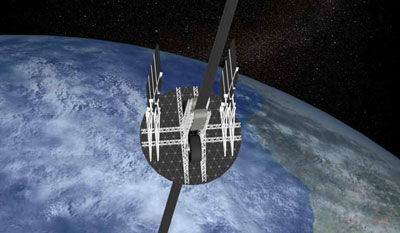The space elevator: going up? (part 1)by Jeff Foust
|
| Early space elevator studies ran into problems because the strongest materials then available were far too weak to support the weight of the full elevator. |
While the space elevator had gained traction among science fiction authors and readers, scientists and engineers had found difficulties with technical aspects of the concept. In one of the first technical studies of the space elevator, performed in the 1950s by artificial intelligence pioneer John McCarthy, the strength of existing materials emerged as the biggest problem. Using the strongest material available at the time, steel wire, McCarthy found that the cable needed to be tapered in order to support its own weight, growing wider as it rose from the Earth’s surface to geosynchronous orbit. The ratio in widths between the surface and GEO, McCarthy calculated, was a staggering 1050. In other words, the space elevator was impossible with the best materials then available.
Other materials that are both stronger and lighter than steel have been developed since McCarthy’s paper, notably graphite whiskers. However, these materials were still too weak to support their own weight without tapering, although in the case of graphite whiskers the taper ratio was a more manageable 100. A 1999 study by NASA’s Marshall Space Flight Center suggested that advances in materials science and other technologies would make a space elevator eventually feasible, but not before the latter part of the 21st century.
Nanotubes to the rescue
Given that pessimistic assessment, it would be easy to simply write off the space elevator as an interesting but unfeasible idea best suited to science fiction novels. That, in fact, is what might have happened had it not been for the curiosity of one Los Alamos National Laboratory scientist, Brad Edwards. He had run across the NASA MSFC report and other comments that suggested that a space elevator might be at least 300 years into the future. Supported by two grants from the NASA Institute for Advanced Concepts (NIAC), Edwards and colleagues, working under the name HighLift Systems, took a new look at space elevator.
| Scientists have calculated the theoretical strength of carbon nanotubes to be as large as 300 gigapascals, nearly 100 times greater than steel and 15 times greater than graphite whiskers. |
This new look was aided by developments in materials technology, notably with a newly-discovered form of carbon called C60, or fullerene. This form of carbon existed in spherical molecules dubbed “buckyballs”, but in 1991 researchers found an extended form of these molecules, tubes capped on each end by a buckyball hemisphere. These “nanotubes”, which can consist of single or multiple layers of carbon atoms, are typically about one nanometer in diameter but can be several thousand times longer.
What made nanotubes of interest to scientists, and potential space elevator developers, was the strength of these materials. Scientists have calculated the theoretical strength of these objects to be as large as 300 gigapascals, nearly 100 times greater than steel and 15 times greater than graphite whiskers. A cable made either of pure nanotubes or a composite material that included nanotubes would be strong enough to support its own weight, eliminating the need to taper the cable. (Interestingly, the MSFC report mentions the use of carbon nanotubes for building the space elevator cable, but wraps it into a much more complex design.) Thus, Edwards found, it would be possible to build a relatively simple space elevator in a short period of time—on the order of a decade, not centuries—that could demonstrate its ability to launch payloads cheaply.
